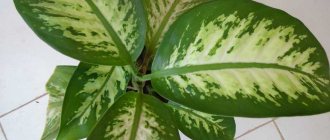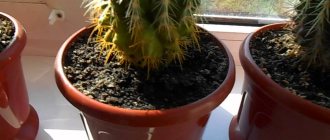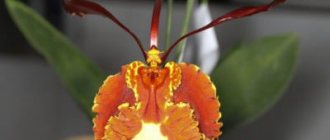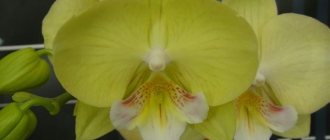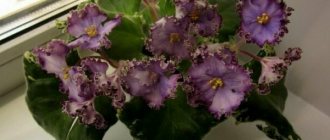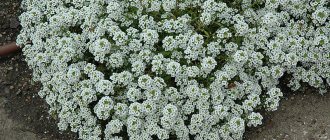Europeans became acquainted with magnificent orchids more than three hundred years ago. The first specimens of these tropical plants, which arrived from the American continent to Holland, amazed even experienced flower growers with their exquisite appearance and duration of flowering .
But in those distant times, exotic beauties could only grow in royal greenhouses. Nowadays, blooming orchids can be seen not only on the windowsills of ordinary apartments.
They fit harmoniously into the interiors of offices and educational institutions, decorate hospitals and libraries, plant greenery in the halls of enterprises and even personal gardens . The successes of flower growers in the study of orchids and the efforts of breeders allowed tropical guests to firmly establish themselves in the homes and hearts of people of the 19th century.
Purchase and adaptation
Select a specimen with elastic leaves, without spots and drying tips. Healthy roots are succulent, green or grayish in color, without rotten or wet areas, the substrate is free of mold.
Newbie homes need to be isolated from your indoor plants. During the first 30 days, monitor it for pests. Water only after drying, when the roots become silvery, and begin feeding a month after purchase. At the end of quarantine, move the flower to a permanent location.
Popular varieties in home culture
Among the numerous varieties of Phalaenopsis, any gardener will be able to select specimens to suit their taste or based on the needs of the collection.
Interesting! The corollas of Phalaenopsis are similar in appearance to butterflies, which gives the name to the whole genus (moth-like). The color palette of flowers includes all rainbow shades, which further increases the resemblance to delicate insects.
For beginners and amateurs, we can recommend the most common varieties in home cultivation, photos of which will help you make a choice.
Phalaenopsis mix
A hybrid specially adapted for indoor culture. Requires minimal care . A large plant (height with peduncle reaches 0.7 m) with large butterfly flowers of all shades of the rainbow.
The leaves are standard for the genus - large, leathery, oval-round in outline . It blooms multiple times in one year with long periods of corolla retention.
Phalaenopsis blue
There are no consistently blue varieties in nature. Several hybrid forms and natural varieties are known with delicate and subtle tones of blue and lilac (sometimes on a white background).
All bright blue specimens sold are tinted with natural dyes using a special technology. The second flowering of such forms is usually white or pale blue , but not all sellers honestly warn about this.
Other characteristics depend on the variety chosen for tinting.
Phalaenopsis Philadelphia
A distinctive feature is large, oval-elongated leaves with a marble pattern, covered with a glossy coating. The inflorescences are of medium height and branch well . It blooms gently with lilac butterflies.
Phalaenopsis Stewart
It is distinguished by narrow, long leaves with light patterns, as well as silvery roots. Multi-flowered inflorescences - sometimes about 60 buds at a time on high peduncles (up to 80 cm) bear small white fragrant corollas.
Blooms during warm periods. Duration – no more than 30 days.
Phalaenopsis Magic Art
Not a very large orchid (about 60 cm) with oval dark green leaves . It is distinguished by brightly colored corollas: crimson droplets are scattered across the white petals, complemented by streaks of the same color.
The middle is red with crimson and yellow tints . Blooms twice a year.
Unusual Phalaenopsis are very popular in culture:
Dendrobium Phalaenopsis
Belongs to the genus Dendrobium, it received its name for the resemblance of the corollas to butterfly orchid flowers.
Dendrobium Phalaenopsis has a sympodial type of growth , that is, it can grow in width due to the formation of new shoots on the rhizome. The leaves are long and narrow. The inflorescences are formed from pseudobulbs, the flowers are white to purple in color.
Phalaenopsis mini
The Phalaenopsis mini orchid differs from other species only in its insignificant peduncle height (no more than 20 cm). It has large thick leaves of green (less often spotted) color .
Blooms both in summer and winter months. Flowers are butterflies of various shades.
Temperature
Phalaenopsis orchid is a tropical plant, the suitable average daily temperature for keeping is 20 -25 degrees. To set flower buds, the difference between day and night temperatures should be from 3 to 5 degrees.
What to do in case of different problems?
Grows from a growing point
It happens in a plant that has had many flowering cycles or has suffered stress (sharp change in living conditions). Provide the flower with proper care and in a short time the peduncle will delight you with flowering.
Broken
The young shoot is fragile and can break if handled carelessly. Do not try to re-grow it, but carefully cut it, powder the cut area with activated carbon or cinnamon powder. Make a cut near the nearest bud. After some time, a new shoot will form.
Not for a long time
It is very disappointing when a plant does not please us with its flowering. The following actions will help to shake it and provoke it to grow a peduncle:
- Move the pot to a dark place.
- Reduce, but do not stop, watering.
- Reduce night temperature by five degrees.
Measures to bring a flower out of hibernation should not be lengthy. A period of seven days will be sufficient.
Stopped growing
Such a nuisance occurs if the plant feels a lack of light, heat, moisture or is infected. Inspect it and change the growing conditions or treat it if necessary. In order for the flower to have enough strength to bloom, it is necessary to fertilize it with minerals or change the soil mixture.
Watering and fertilizers
Methods of watering orchids:
- immersion The pot is placed in a container of water;
- spillage around the edges of the pot;
- warm shower.
You can determine that moisture is needed by the color of the roots: when dry, they become silver in color. The substrate must dry completely. Use soft, settled water, otherwise salts will settle on the roots.
You need to make sure that moisture does not get into the growth point, this will provoke the development of diseases. Remove water from the outlet with a dry cloth. How and when to water a flower depends on the growing conditions.
Healthy plants are fertilized, sick and flowering ones are not. After transplantation, do not use fertilizing for a month. Fertilizer preparations are diluted according to instructions and watered well before application so as not to burn the root system.
How to choose Phalaenopsis in the store
In order for the orchid to quickly adapt to its new apartment conditions and feel comfortable, when purchasing a plant you should take into account some nuances:
- It is possible to determine the color of a future pet only in a blooming state. In addition, blossoming buds without disturbing the richness of color , firmly sitting on the peduncle, will show a healthy plant. – Buy an orchid during flowering.
- A sick plant will be revealed by its root system: if the roots are sluggish, with spots of rot, and the orchid sways in the pot when touched, then you should not buy it (the flower is weakened). – When purchasing, check the health of the roots.
- A healthy orchid certainly has powerful, fleshy leaves . They should not have cracks, scratches or dry areas. Most varieties have dark greens. – When buying an orchid, pay attention to the leaves.
Lighting and Humidity
The process of photosynthesis requires light. It is important to choose the optimal lighting intensity. Under natural conditions, representatives of the species grow under the forest canopy, in the shade, and in the direct rays of the sun in summer, leaves and roots can get burned.
When growing tropical beauties at home in winter, special phytolamps are used for additional lighting.
If it is necessary to increase air humidity in the summer heat, or in winter during the heating season, place a container of water next to the plants and use air humidifiers.
Reanimation
Maintenance errors can most often lead to loss of roots, lack of leaf turgor, and premature falling of flowers and buds. Such plants will need resuscitation.
If leaf turgor is lost due to untimely watering, periodic bathing in well-warm water and increasing air humidity can save the situation.
In case of partial or complete loss of roots, it is necessary to replace the old substrate, temporarily stop watering the pot and replace it by spraying the surface of the substrate. If there are no roots at all, you can place the rosette in a bowl with damp moss.
Such flowers will have to be fertilized and watered leaf by leaf.
You can grow roots on damp moss.
You will learn more about the resuscitation of phalaenopsis from this article. In this article you will find complete information on how to grow plant roots.
Caring for sick plants
Resuscitation also includes caring for sick flowers. However, if we are talking about a plant being damaged by diseases and pests, then it is necessary to treat it with special preparations and keep such a specimen separately from other plants until complete recovery.
It is also recommended to keep phalaenopsis that were recently purchased , since in a store with a large concentration of plants there is a high probability of infection with diseases and pests.
Read this article about how to properly care for plants after purchase.
Bloom
Phalaenopsis in the wild has its own development cycle. In natural habitats, the rainy season gives way to the dry season, and the time for flowering begins. With proper care indoors, the orchid grows leaves and roots, then a peduncle forms.
To keep it erect, as it grows, it is tied to a support. At this time, the development of the vegetative mass stops; no fertilizing is necessary. The blooming buds show off for several months.
If the peduncle remains green, it should not be cut. The remaining buds can form new shoots.
3. Phalaenopsis varieties
It is very difficult to describe all varieties of phalaenopsis - after all, there are a great many of them, let’s look at just a few.
3.1. Schiller's Phalaenopsis - Phalaenopsis schilleriana
A profusely blooming species with large, pink flowers on drooping stalks that have a rose scent. The homeland of the plant is the Philippines. It has become widespread due to its unpretentiousness and tolerance to low lighting levels. An excellent hanging plant, which during the flowering period will hang large branched flower stalks with a cascade of pink flowers over the edges of a hanging flowerpot.
↑ Up,
3.2.Phalaenopsis Sogo - Phalaenopsis Sogo
A small, compact, large-flowered orchid with very bright colors of buds in all colors of the rainbow. Among this variety there are variegated plants with yellow longitudinal stripes on thick, fleshy leaves. The orchid's peduncles are strong, erect, and during the flowering period the plant emits a very pleasant aroma.
↑ Up,
3.3. Phalaenopsis Liodoro - Phalaenopsis Liodoro
A miniature multi-flowered subspecies with bright, soft, green leaves and short, often drooping flower stalks. The flowers are very brightly colored - the edges of the petals have a yellow tint, and towards the center they are abundantly covered with small specks, merging into a solid pink or lilac tone.
↑ Up,
3.4.Phalaenopsis Mini Mark
A very beautiful, small-flowered plant, reaching a height of only 10 - 15 cm. The leaves are dark green, relatively large, glossy, slightly bent along the central vein. The peduncles are tall and thin, bearing small flowers at the top with white oblong petals covered with red or pink specks - freckles. The lower lip is painted a bright orange shade.
↑ Up,
Transfer
After the end of lush flowering, you can begin the transplantation procedure. Usually the reason is the removal of transport soil or the growth of the root system, the need to replace salted pieces of bark.
To ensure the process of photosynthesis in the roots of the epiphyte, the substrate must be:
- loose;
- moisture-absorbing;
- breathable;
- light.
You can find a ready-made mixture for orchids on sale. The composition includes: the main component is pine bark, sphagnum, charcoal, coconut chips or fiber, peat. If the soil is prepared independently, it is important to consider the following points: the collected bark must be disinfected and the resin and tannins removed from it.
Choosing a pot is another difficult task for a novice gardener. The best option is a transparent container with many holes for water drainage and root aeration.
The assortment on store shelves is presented in the following options:
- plastic transparent pots - simple, with drainage holes;
- colored translucent - the light necessary for the roots penetrates them;
- “crown” system - more suitable as a flowerpot for a pot;
- ceramics or glass - delicate roots grow to the walls, you need to properly regulate the amount of moisture in the soil; this growing method is not recommended for beginners.
During transplantation, the plant is removed very carefully, trying not to damage the fragile roots. Thin threads without velamen, blackened areas are removed with a sterile instrument.
Check to see if there is a plastic cup under the neck; if it is in the way, it should be carefully removed. The roots are distributed in a new pot, the aerial ones are also placed, if possible, and the substrate is added.
And then they simply leave the transplanted plant alone and give it time to adapt. Abundant watering and fertilizing during this period will have a detrimental effect.
Recommendations for care
Creating the right environment is very important:
- The most important factor for phalaenopsis is light. In natural conditions, the plant lives under the canopy of trees, so although they need a lot of light, it should not be direct sunlight.
- The second most important factor is watering; you can’t overdry them, but this doesn’t mean you need to water them. The humidity in the room is not important for phalaenopsis, the main thing is proper watering.
Unlike other types of orchids, phalaenopsis does not require annual replanting, special fertilizers, or daily spraying. But a newly purchased plant needs special care. In a new place, the plant begins a period of adaptation . Its leaves and buds may begin to fade.
Even after a thorough inspection in the store, phalaenopsis can carry parasites, so it needs to be isolated from other plants for a couple of weeks. If everything is fine with it after quarantine, you can place it next to other flowers.
If you find salted bark in a pot, remove it immediately. Make sure that there are drainage holes in the pot; if there are none, make them, but do not damage the roots.
The plant should only be replanted if the plant looks sick . damage is visible on the roots or it falls out of the pot.
It is necessary to accustom phalaenopsis to light gradually; do not immediately place it in a brightly lit place.
Reproduction
The first purchased specimens have taken root in the apartment, they delight us with their flowering, now it’s time to master the techniques of propagating graceful beauties.
In its natural habitat, the ornamental crop reproduces by dusty yellowish seeds. At home, if you have a strong desire and patience, you can take care of flowering plants, carry out pollination yourself, and collect seeds after 5-6 months. Growing seed material is carried out in a prepared sterile environment; the process is complex and lengthy for breeders and advanced collectors.
Other propagation methods:
- children;
- cuttings from flower stalks.
Children appear on the peduncle, on the trunks (if the main growth point has died), between the leaves. The babies are not separated from the mother plant until they have grown several leaves and their own roots to ensure independent life.
After flowering has finished, cuttings are cut from the peduncles. They can be rooted in homemade plastic greenhouses. If successful, the root formation process lasts about a month.
Questions about content
Next, we will answer some of the most common questions about how to care for phalaenopsis (phalaenopsis).
How do you know when it's time to water?
If an orchid grows in a transparent hill, then you should pay attention to the color of the roots.
Beginners should place a wooden skewer or long sliver of wood in the center of the pot when replanting. Before watering, you need to pull it out and look at its condition.
If the skewer is wet, then watering should be postponed.
How to care for a painted plant?
Caring for painted phalaenopsis is not particularly different , but the viability of such plants is much lower due to the influence of the dye. When purchasing, it is better to choose a plant with a natural color, because over time, blue or dark blue flowers will inevitably turn white.
Do you need lighting in winter?
Phalaenopsis can easily survive the winter without lighting, but poor lighting can still stunt growth and delay flowering. To avoid this, you can use special phytolamps to increase the length of daylight hours.
Orchid lighting.
How to wake up phalaenopsis?
Sometimes the plant freezes and stops growing. Often this phenomenon occurs due to unfavorable conditions, for example in winter with a lack of light and lower temperatures . When conditions improve, phalaenopsis begins to form new leaves again.
Such periods of rest are quite normal. The flower cannot grow continuously and requires short breaks to gain strength to grow new roots and leaves.
What should be the care during flowering?
Care during flowering is not much different from normal daily care.
However, you should try to move the orchid less and rotate it around its axis while the flowers are blooming, and also avoid drafts and moisture getting on the flowers.
You can prolong flowering a little with the help of special fertilizers.
Do you need LED phytolamps?
Special lamps can be used when there is a severe lack of natural light. If the light mode is normal, then there is no need for lamps. However, in winter, when light levels are low, phytolamps will help stimulate flowering and not stop growth.
Rejuvenation
In an elongated bush with a large number of aerial roots, the upper part with leaves and roots is cut off with a sharp sterile pruning shears. Leaves are also left on the mother plant; children will develop on the old trunk.
The cut part is dusted with crushed coal or cinnamon, dried, and planted without deepening so that the root collar does not become damp.
A detailed description and step-by-step instructions with photos for propagating the Phalaenopsis orchid can be found on websites for gardeners; it’s easy and exciting.
What kind is this?
Phalaenopsis is a herbaceous plant belonging to the Orchid family. Under natural conditions it grows in hot climates with high humidity, mountain and lowland forests.
The plant grows straight up, reaching 50 centimeters . There are a great many color variations, from plain to two-color, striped, etc. The flowering period is from 2 to 6 months, sometimes it can bloom 2 times a year. An adult plant has 4-6 leaves; two large fleshy leaves grow in a year.
Phalaenopsis got its name because the flower resembles a fluttering butterfly.
Errors in care
The most common errors:
- watering with cold, hard water;
- frequent watering without breaks for drying;
- choosing the wrong place - lack or excess of lighting, drafts;
- overdoing the application of fertilizers.
After eliminating these errors, the orchids will thank you for your attention with a wave of luxurious flowering.
Watering frequency by period
During different periods of the life of the phalaenopsis orchid, it requires different watering regimes. Flowering, more active growth and even wilting can depend on this factor.
Each period has its own watering frequency:
- During the period of active growth, the orchid is watered once every 5-7 days, depending on the conditions of the surrounding microclimate;
- In order for the stem to begin to expel the peduncle and have more buds on it, it is effective to use a warm shower, which will imitate the flower’s natural living conditions;
- Gradually, the flowers on the arrow bloom , this should become a sign in order to shorten the breaks between waterings. Now the phalaenopsis orchid will need watering every 2-3 days. In addition, a warm shower is not canceled, which will prolong flowering;
- After removing the peduncle, the overseas beauty needs to be given time to rest. To do this, the replenishment of moisture reserves is reduced, watering is done once every 10-12 days. Sometimes you can foliar feed the plant by spraying.
Important! It is worth remembering that from an excess of moisture, the roots of an orchid can easily rot. It's better to underfill than overfill.
Photo of Phalaenopsis Orchid plant
Flower birthplace and origin
In nature, these plants can be found in Asia, Australia, the Philippines, and in places with a humid tropical climate.
The genus owes its name to K. Blume, the director of the botanical garden, who at dusk mistook an orchid flower for a butterfly. Phalaenopsis is a Greek word meaning “moth-like.” And indeed, in its shape it resembles this fragile creature.
In Ancient Greece they saw another similarity, with a slipper or shoe. However, such elegant shoes are not suitable for earthly creatures. She is worthy only of the feet of the Goddess of Beauty. Hence the name - Aphrodite's slipper.
Agricultural technology
All reasons associated with withering, poor growth or even death of the plant are associated with ignorance of the rules of care and agrotechnical cultivation techniques.
Planting or transplanting
Ideally, the transplant should be done so that the orchid does not notice it. No fading or stress should occur. But in reality, there will still be stress.
Transplantation should be done immediately after purchasing a new hybrid. And fill the new container up to the leaves. Those. deepen by 2-3 cm.
It is in this place that new roots will begin to grow. Nothing new will appear in the old rhizome.
Also, when replanting, you should replace the commercial moss and filler with new ones. That moss is already pretty greasy and the plant will feel uncomfortable.
After transplantation, the leaves should not be exposed to sunlight until complete rooting. But the illumination must be full and sufficient in duration.
The purchased orchid is carefully removed from the pot and freed from the old filler. The substrate sprouted into the roots is not torn off and the roots do not unravel. Rotten and dry roots are cut off. Yellow roots are considered normal and should not be removed.
The bottom of the container, which should be slightly larger than the diameter of the root system, is filled ¼ with clean bark, and its largest fraction is placed on the bottom.
The substrate should not be compacted. It is compacted by tapping the wall of the container or shaking it. The orchid must be located in the center of the pot and stand strictly vertically, regardless of the root system and peduncles.
Holes should be made in the bottom of the pot. It is best to soak clean bark for a couple of days before planting. Do the same with a substrate or a special purchased mixture - moisten it, let the water drain and dry it a little.
If the bark is fresh (does not take up moisture), there is a danger to the plant. To do this, it is mixed with moisture-intensive components, such as sphagnum moss or coconut chips. It is possible to boil the bark for 12-15 hours. Then it is planted in a moist substrate and watered.
Watering
Phalaenopsis needs a slightly moist substrate at all times. Overdrying threatens his death.
There are no specific watering intervals for it. It all depends on temperature, humidity and light. But it should always be slightly damp. You can deepen your finger 5 cm and check the moisture.
It is necessary to learn to determine the timeliness of watering , avoiding drying out or waterlogging, and then it will grow and develop safely.
Do not allow the substrate to dry out or become waterlogged.
Nutrition
Only rooted and actively growing plants are fertilized . Feeding during dormant and cool periods is harmful. Nutrition is introduced from April to September, during the period of active development. Additional nutrition must be added strictly according to the manufacturer's instructions. Otherwise, it will only bring harm.
Advice! Fertilizer should not be used when replanting a newly acquired hybrid.
Diseases and pests
Most often, the orchid is affected by non-infectious diseases . Exposure to sunlight causes burns on the leaves. Yellow spots appear if the flower is in a cold place or is poorly lit. Unreasonable watering leads to plant rotting. If an orchid has dropped its leaves, it means that the flower has been standing for a long time in a draft or under a stream of air from an air conditioner.
Viral diseases that occur in orchids:
- anthracnose;
- powdery mildew;
- rust;
- black fungus;
- rot.
Treatment is carried out by spraying with Ritomil, Mikasan, Skor . You can wash the plant in a solution of foundation or vitriol.
Pests:
- aphid;
- scale insect;
- worm.
First, the infected plant is washed under a warm shower (many pests die at temperatures above 40 degrees), then the pests are selected by hand and the orchid is treated with a 0.3% foundationazol, 0.2% benlate composition.
Several procedures are carried out with an interval of 2 weeks.
Some folk remedies help well: a solution of green soap, brewed onion and garlic peels.
We discussed in more detail issues related to diseases and pests of phalaenopsis, as well as ways to combat them, in this material.
Phalaenopsis care
Caring for a phalaenopsis orchid involves the ability to create the necessary balance of temperature, air humidity and substrate. At first glance, it seems simple, but in reality it turns out that orchids are very short-lived. This is because the microclimate in our home is constantly changing, it largely depends on the weather outside, and not everyone can adapt. For plants, like a mini-ecosystem in a pot, changes of even 2-3 degrees or 3-5% of air humidity make a difference in the frequency of watering and ventilation.
Temperature and fresh air
Phalaenopsis are thermophilic, which means that in winter they do not need a cool room, and in summer they should not be left on an open balcony if it is cold at night. Comfortable temperatures for these orchids during the day are 23-28°C during the day, up to a maximum of 33°C, at night it is desirable that the temperature drops by 5-8°C, i.e. 18-20°C, at least 14°C. Minimum and maximum temperatures are for a short time, i.e. a flower can remain in such conditions for 4-5 days, but during the heat it is necessary to increase air humidity, and when the thermometer drops to the lower limit of the permissible limit, the orchid roots must be completely dry and no spraying!
For orchids, a regular flow of fresh air is very important, i.e. it is necessary to establish a ventilation regime so that when the air temperature is below 20°C, air flows are not directed towards the plant. Phalaenopsis can easily tolerate a small draft, but only if the air is not cold. That is, air conditioning is an enemy, not a friend! With high soil and air humidity, phalaenopsis orchids simply need airflow - like a light breeze, in which there is no visible vibration of the leaves. In a poorly ventilated area, pathogenic fungi and bacteria that cause phalaenopsis diseases develop very quickly. Fans solve the problem only partly; if there is no influx of fresh air, then we simply circulate the air and the microorganisms suspended in it around the room.
Therefore, the recipe is simple: pots with phalaenopsis should be placed in such a way as to ensure mobility - when ventilated, they can be easily moved from the windowsill to a cabinet or shelf if the air temperature is below 20°C. Remember that hypothermia is especially dangerous in damp soil.
Lighting Phalaenopsis
Phalaenopsis is light-loving; in natural conditions it grows in such a way that the sun's rays fall on it, but openly, through the “windows” between the leaves of the trees. Burns do not occur even on hot and sunny days, because these windows constantly move after the sun. This means that at home, an eastern and bright north-western window is ideal for phalaenopsis - if they are not shaded from the street by houses or trees. South, west, south-west direction of windows - shading is needed in the hottest hours of the day from 11:30 to 16:00 (in hotter times and southern regions until 17:00), ideally - blinds or a double layer of mosquito net. Northern windows for phalaenopsis, as well as windows of other orientations, shaded from the street by trees or houses (especially the first floor) are not the most suitable place without artificial additional lighting if you want the orchid to both grow and bloom.
For active growth and development, the phalaenopsis orchid needs good lighting. The duration of daylight is at least 10 hours. If there are no such conditions, then the phalaenopsis will not grow leaf mass, which means it will not bloom. And if you place a purchased flowering phalaenopsis orchid on the windowsill, it will bloom, perhaps it will grow, but the new leaves will be smaller than the previous ones, the lower leaves will gradually turn yellow and oh. But these are all general concepts, the real indicator of suitable lighting is the size of the sheet - the new sheet should be the same size as the old ones.
Sometimes the conditions at home are such that the lighting is uneven - sometimes better, sometimes worse, phalaenopsis grows in fits and starts, while there is enough light, grows one small leaf, but then slows down again and stops growing for a long time. It blooms periodically, but with smaller flowers, or when it suddenly gathers buds it dries them out. In such situations, phalaenopsis live for 3-4 years, gradually seem to decrease in size, and eventually simply wither away. Meanwhile, under good conditions, phalaenopsis can live at home for many years. If your windows are not light enough, you just need to arrange additional lighting with lamps.
If the windows are not sunny, or are covered with curtains, one such lamp is not enough - the orchid will finish flowering, the new growth will be frail. You need one 20 W bulb on both sides of the bush, a distance of 10-15 cm.
Here, additional lighting is only on one side - the flower stalks themselves reach for the light, but this is not enough to increase the leaf mass, especially in winter.
By the way, phalaenopsis grows well all year round under artificial light - use fluorescent lamps or LED lamps (white light 4000 K). You can purchase special phytolamps, but this is not at all necessary.
How to water phalaenopsis
Phalaenopsis should be watered using the immersion method. This is the only acceptable method for the reason that between waterings the substrate (if any) must dry completely and remain dry for several days. If you water such a substrate from a watering can, the water will simply flow over the dried bark and roots into the pan, and the roots will not have time to drink. Therefore, you need to choose a wide jug so that the pot with the plant fits freely into it to the very top. We fill it with water at a temperature not lower than the ambient air, it is better to warm it slightly to 35-37°C, and leave for 10 minutes. 10 minutes is more than enough for the velamen to absorb water. If the phalaenopsis has not been watered for a very long time, say two weeks, then you can leave it for 15 minutes, but no longer. Also make sure that the bases of the lower leaves are not floating in the water. That is, you only need to wet the roots in the pot and the bark, and the roots at the base of the leaves and the axils of the lower leaves should remain dry. If water does get in, be sure to dry it - fold a piece of toilet paper into a corner and blot all your sinuses.
Important
The correct watering of phalaenopsis depends entirely on the correct choice of pot and substrate.
In nature, the roots of orchids are not limited by the walls of the pot, they are not covered with a layer of earth and plastic, all rainwater drains from the roots and leaves without stopping. Therefore, the pot should have many drainage holes at the bottom (or a mesh instead of a bottom), preferably several large holes in the walls. The substrate is made up of large fractions of bark (pieces about 2-4 cm in size) and plenty of free space. This is necessary so that the orchid roots dry out very quickly. Ideally, the roots should dry out within 24-36 hours after watering. The bark itself may take longer to dry, but since large pieces of bark do not stick to the roots, there is no threat. If the roots of a flower remain wet for longer than 1-2 days, and they remain when the pot is filled with finely chopped bark mixed with moss, then rotting, and then disease and death of the plant, is inevitable. Healthy roots are light gray with a green tip.
Guidelines for proper watering:
- dry healthy roots are light gray, without a tint of brown, rather silver
- after getting wet they acquire a gray-green color
- after 24-36 hours they should turn gray again
Watering frequency
Phalaenopsis needs to be watered depending on the temperature - the higher the temperature, the greater the evaporation of moisture from the leaves, i.e. when it's hot - more often, when colder - less often. On average, at temperatures above 22-24°C approximately once a week. When there are very dry hot days in the summer (up to 30°C and above during the day) - once every 3-4 days, if the temperature is below 22°C, approximately once every 7-9 days. All this provided that the orchid dries within a day! If it takes longer to dry, do not water until everything is 100% dry, no “half drying” - the roots should be completely dry by the next watering.
Watering frequency is one of the flower control elements in Phalaenopsis.
There is no need to immerse the entire phalaenopsis in water; the water should not touch the base of the leaves.
Soaking in water for 30 minutes or more leads to the formation of mold and rot.
Watering errors
It is absolutely unacceptable for the roots of phalaenopsis along with the bark to dry in a pot for 5-7 days, so the frequency of watering (the speed of soil drying) depends on the weather - ambient temperature and humidity. As soon as the humidity increases when the weather changes (rainy, cloudy, especially when the heating has already been turned off or has not yet been turned on), carefully monitor the condition of the bark. If you notice that three days have passed, it is still damp, and the roots are still green and not light, do not expect rot - put the pot on its side and shake out some of the bark. It is not yet necessary to empty out the entire contents of the pot; even halving it will speed up the drying time, and everything can be done just fine.
What water to water
Water for watering phalaenopsis needs only soft water; if your area has hard water, then special filters are needed to eliminate excess salts. Conventional filters purify water from mechanical impurities, excess chlorine, heavy metals and that’s all. In nature, orchids drink rainwater with nutrients dissolved in it from the bark of the trees on which they grow. Our tap water contains many things that are harmful to orchids: chlorine, fluorine, iron.
By the way, it is generally very difficult to get rid of excess fluoride; reverse osmosis filters are needed. The need for them arises when it is reliably known that the fluoride content in the water in your area is exceeded. These indicators vary greatly not only among regions and districts, but also within the same city. Meanwhile, fluorine in irrigation water is toxic to phalaenopsis, inhibits growth, and causes the development of leaf necrosis. Increased fluorine content in water is observed in industrial areas, especially where there is aluminum production, fertilizer plants, etc. And fluorine levels in water should not exceed 0.05 mg/l.
Thus, orchids should be watered with at least filtered and boiled water, if a very good filter - filtered, but not tap water. There is an option to water with distilled water, if the orchid grows exclusively in the bark (without polystyrene foam, cork), then while the bark is fresh you can do without fertilizing, but gradually the nutrients are washed out from the bark (over three months), and fertilizers will have to be added to the distilled water with each watering, but reduce the dosage by about 3-4 times the recommended one.
But it’s even better to visit an aquarium store and purchase products for preparing water for an aquarium. Specialists breeding tropical fish have long used a wide range of drugs that allow them to measure the pH of water and change it in one direction or another: pH+ and pH-. There are means that make tap water suitable for life for fish, and in our case, orchids, almost immediately.
Feeding
The crucial point is feeding phalaenopsis; the difference here from other indoor plants is that feeding does not depend on the time of year, but depends on the physiological state of the plant.
Schultz orchids NPK 19%-31%-17%, 1/2 teaspoon per 3 liters of water.
Bona Forte for orchids NPK in a ratio of 4:2.5:6, dilute 5 ml per 1.5 liters of water.
Let's immediately outline the moments when you can feed phalaenopsis and when you can't:
| can be fed | you can't feed |
| plants in leaf growth phase | plants showing no signs of growth |
| orchids that do not have rot or other diseases | orchids with rotting roots, with fungal and bacterial infections |
| The peduncle begins to grow, buds form | from the moment the buds open until the end of flowering |
| weekly orchids grown without a substrate or completely on an inert substrate (cork, foam, etc.) | orchids planted in fresh bark, the first month after transplantation |
| when watering with distilled water | when watering with aquarium water, salt deposits appear on the walls of the pot and the bark |
If you bought a blooming phalaenopsis orchid, do not rush to feed it, even forbid yourself to do it - only water it, just with water. By starting to feed, you can stimulate the plant to grow - it will dry out the flowers and continue to grow leaves.
Air humidity
There is an opinion that phalaenopsis require high air humidity of about 60-80%, this is partly true - a comfortable humidity for them is just 60%. But even at 50% they feel good without spraying. When spraying is needed - when air humidity drops below 40%. Higher is completely unnecessary, even unnecessary, and can even cause harm if drops of water fall into the axils of the leaves or spraying interferes with the rapid drying of the soil after watering. But humidity above 60% can be risky, as already mentioned due to the length of time it takes to dry the substrate and the likelihood of the development of pathogenic microorganisms. Phalaenopsis are very susceptible to rot and bacteriosis, so when humidity is above 60%, very good ventilation is needed! Do not forget that in natural conditions, the average humidity is 70-75%, but round-the-clock ventilation is wind.
Therefore, if the air is very dry, for example, in winter, in severe frosts, the hair from the comb flies up, the curtains sparkle, the humidity is about 20% - phalaenopsis orchids can be sprayed with a small spray bottle, but it is better to place a humidifier nearby, or cover the radiators with damp sheets as soon as they dry , wet again.
Description of the plant
Phalaenopsis is an epiphytic plant of the Orchidaceae family.
Orchid grows on tree trunks and even rocks
The roots of Phalaenopsis both in their purpose and in structure. They are divided into main and subordinate ones. With the help of the main roots, the plant is attached to the tree trunk and always grows vertically, upward. Adventitious roots are located between the leaves and are aerial.
Sometimes they look very exotic, forming a “beard”
Like leaves, roots are capable of photosynthesis. This explains their unusual gray-green color for roots and their special structure, reminiscent of the tissues of succulent leaves that can retain moisture.
Orchids have a short stem with sessile large (from 7 to 30 cm) dense leaves of a rounded elongated shape located on it in pairs. On adult specimens there are from 4 to 6. During each year, 2 leaves appear, increasing the overall height of the plant.
The flowering of a plant begins with the appearance of a peduncle. It can branch, stretching up to 70 cm, and bears a large number of buds.
Thanks to the sequential opening of the buds, the flowering of orchids lasts for several months.
Phalaenopsis
The flower consists of 3 lateral sepals (sepalia), 2 lateral petals (petalia) and a central part, the so-called lip. Its task is to attract and accept, like a “landing site,” pollinating insects.
Phalaenopsis flowers can have the most incredible shapes and colors
